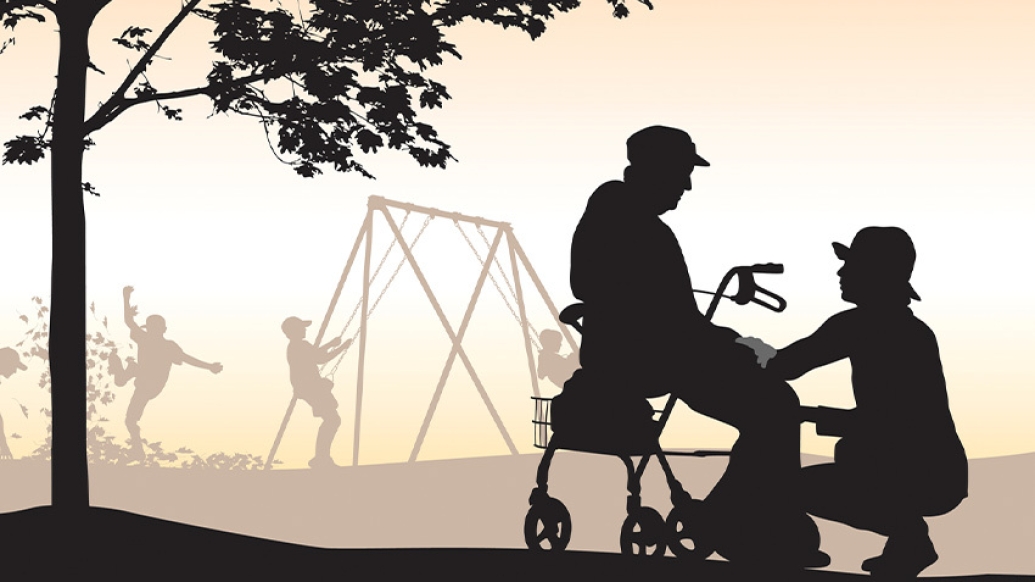Millions of Americans juggle caregiving for two generations; new analysis shows the strain on their time, and financial and mental health.
11:38 AM
Author |

Their older parents need care. Their kids are still under 18. And they probably have a job, too.
They're the "sandwich generation" – a longtime nickname for the mostly female, mostly middle-aged group of Americans who serve as caregivers for both older and younger family members at once.
A study estimates there are at least 2.5 million of them, while giving a detailed view into who they are, and which older adults rely on them.
In all, nearly one quarter of adults who provide care for at least one parent over the age of 65 also take care of at least one child under 18, according to the new study from a team based in the University of Michigan Department of Psychiatry.
Writing in the Journal of the American Geriatrics Society, the researchers show how being in the middle of a caregiving sandwich differs from being a caregiver with an older adult, but no minor children, to care for.
SEE ALSO: A critical source of health help for older loved ones
Overall, sandwich generation caregivers were twice as likely to report financial difficulty (36% vs. 17%) and more likely to report substantial emotional difficulty (44% vs. 32%) than their peers who only act as caregiver to a parent over 65.
Those in the middle of a caregiving sandwich also had a higher average score on a measure of overload than those with only older adult caregiving duties. Both groups of caregivers had about the same average score on a measure of positive impacts of caregiving.
Health policy implications
In addition to taking care of parents and kids, sandwich generation caregivers are also more likely than other caregivers to work for pay (69% vs. 54%). Yet both they and their parents are also much more likely to have Medicaid coverage, which is open to people with lower incomes (21% vs. 11% for caregivers, and 30% vs. 21% for their parents).
That makes this group of caregivers a unique group for policymakers to pay attention to, given their particular needs, the researchers say.
Policymakers and employers should pay special attention to the individuals caught in this 'trilemma' of being caregivers to two generations and members of the workforce at the same time.Donovan Maust, M.D., M.S.
The help of a family caregiver might make the difference between an older person living independently and their need to move to a nursing home; the federal/state Medicaid program pays for the care of 60% of all nursing home residents. This is especially important in the face of a rising median age for first-time mothers and smaller numbers of children per family.
The study was done by U-M Department of Psychiatry postdoctoral fellow Lianlian Lei, Ph.D., geriatric psychiatry associate professor Donovan Maust, M.D., M.S., who is also a member of the Center for Clinical Management Research at the VA Ann Arbor Healthcare System and of the U-M Institute for Healthcare Policy and Innovation, and Amanda N. Leggett, Ph.D., an assistant professor at the Wayne State University Institute of Gerontology & Department of Psychology.
How the study was done
The researchers combined data from the National Study of Caregiving and the National Health and Aging Trends Study. They painstakingly paired the anonymous survey data of caregivers with their parents.
In all, they had data from 1,106 caregivers – 194 of whom had at least one child under 18. These sandwich generation caregivers took care of a total of 436 older parents for whom survey data were available; the 912 non-sandwich caregivers took care of 1,217 older adults.
SEE ALSO: Wide variation seen in family caregiver availability for people with dementia
The surveys did not include information about the characteristics of the children under 18, nor any young adults or grandchildren who caregivers might have had some responsibility for.
In all, about 60% of both caregiver groups were women, and the groups had similar racial/ethnic, marital status, education, and income makeups. However, the sandwich generation caregivers were younger on average (46 vs. 56 years for non-sandwich caregivers, with 35% of sandwich generation caregivers under age 45 compared with only 9% of non-sandwich caregivers).
Differences in caregiving experiences
The older adults who the sandwich generation caregivers took care of were more likely to be living in a setting other than the residential care offered by nursing homes and assisted living centers (91% vs. 78%).
Both groups put in about 75 hours of caregiving in the past month. In keeping with their age, non-sandwich caregivers had been taking care of their older parents for about 8 years on average, compared with 5.5 years for sandwich generation caregivers.
The two groups of parents differed in some important ways, with those who had a sandwich generation caregiver being younger on average, more likely to be married and less likely to live alone. They also received more hours of care on the whole and were more likely to have multiple caregivers helping them.
Among the caregivers in the study who also worked for pay, there was no difference between the two groups in missing work due to caregiving or doing less work while at work, called 'absenteeism' or 'presenteeism'.
Only a minority of both groups used supportive services to help with their caregiving duties, such as caregiver training and support groups, though the sandwich generation caregivers were more likely to have found financial support programs for their aging parents. This fits with the higher percentage who are eligible for Medicaid.
"Our analysis highlights the extraordinary level of demand faced by sandwich generation caregivers, who by many measures provide as much support to their aging parents as the non-sandwich caregivers, while also taking care of children under 18," says Lei. "More research is needed on this specific population's challenges and needs."
"Policymakers and employers should pay special attention to the individuals caught in this 'trilemma' of being caregivers to two generations and members of the workforce at the same time," says Maust. "Making support services and paid time off available to all caregivers of older adults, whether they are taking care of aging parents, other relatives or friends or neighbors, could make a difference in workforce participation and even nursing home use."
Live your healthiest life: Get tips from top experts weekly. Subscribe to the Michigan Health blog newsletter
Headlines from the frontlines: The power of scientific discovery harnessed and delivered to your inbox every week. Subscribe to the Michigan Health Lab blog newsletter
Like Podcasts? Add the Michigan Medicine News Break on Spotify, Apple Podcasts or anywhere you listen to podcasts.
The study was funded by the National Institute on Aging (AG075145, AG056557, AG056407, AG053760, AG054004, AG032947).
Paper cited: "A national profile of sandwich generation caregivers providing care to both older adults and children," Journal of the American Geriatrics Society. DOI: 10.1111/jgs.18138

Explore a variety of health care news & stories by visiting the Health Lab home page for more articles.

Department of Communication at Michigan Medicine
Want top health & research news weekly? Sign up for Health Lab’s newsletters today!





